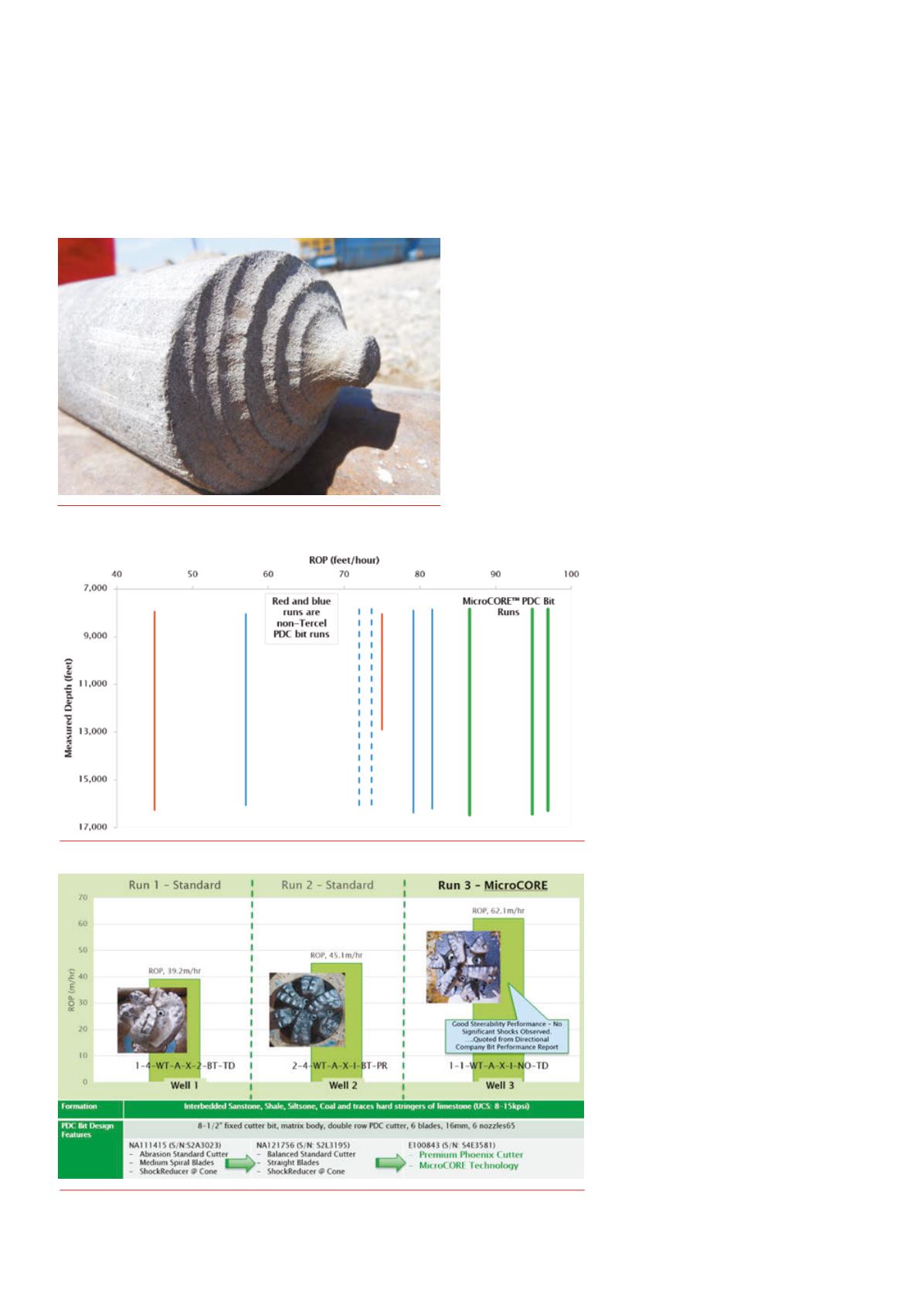
40 |
Oilfield Technology
June
2015
penetration enhancement. There are three key benefits that the cutting
systemdelivers, they are:
Ì
Ì
Improved cutting efficiency.
Ì
Ì
Improved bit stability.
Ì
Ì
Improved steerability.
These product benefits help deliver the ROP enhancement
objectives desired for the engineering projects launched to develop this
technology.
Progressivecuttingefficiency
The primary driver for ROP enhancement in drill bits is finding the
most efficient methods for destroying a given volume of rock. This is
essentially cutting efficiency. In most cases, when design features are
changed to improve cutting efficiency, there is generally a trade off with
bit durability. For example, a common method for improving efficiency
is to lower the backrake angles of the cutting structure. However, lower
backrake angles make the cutting structure more susceptible to impact
damage, thus reducing the bit’s inherent durability.
Conversely, the MicroCORE cutting system improves the mechanical
efficiency of the drill bit without sacrificing durability. This is because
the fundamental changes to the cutting structure allow the energy
being delivered to the bit in the form of weight on bit and RPM to more
effectively be used to destroy the rock being drilled.
Figure 3 illustrates the energy consumed by a PDC drill bit while
drilling versus the radial location on the drill bit. The blue bar data series
in the chart illustrates the energy consumed by a standard PDC bit and
the green bar series shows the MicroCORE cutting systemPDC. Notice
that the energy consumed in the centre of the bit is quite high relative
to the outer portions of the drill bit. This is because the shearing of rock
in the centre of the bit is highly inefficient on a traditional PDC cutting
structure. With the MicroCORE, these cutters have been removed
(Figures 1 and 2), and the energy that would be consumed by the centre
of the cutting structure is redistributed to the outer portions of the drill
bit. Thus improving cutting efficiency and ultimately improving ROP.
Improvedbit stabilityand
steerability
Bit stability is also a key factor that impacts the
rate of penetration of the drill bit. It is easy to
imagine that if a PDC bit is drilling with minimal
vibration allowing it to rotate smoothly with
the cutters having constant and consistent
contact with the formation, it will drill more
efficiently. There are many factors considered in
the bit design process to ensure that the cutting
structure is laid out in a way to drive primary
stability and also that features are incorporated
into the frame of the bit to help it recover from
periods of vibration.
One of the key design elements that has
been considered as part of this process is the
radial profile of the bit. Figure 4 illustrates
two different profiles for fixed cutter drill bits.
The profile on the left shows a shallower cone
where the profile on the right shows a deeper
profile. At a macro level, a deeper profile is
considered to be a more laterally stable design
profile because the uncut formation in the
centre of the bit tends to keep the bit drilling
more smoothly on centre. However, the deeper
profile tends to be less steerable and can also
have more durability issues. The deep cone
profile is generally less steerable because
the uncut formation in the centre of the bit
prevents the bit from deviating from its existing
course. And, the profile tends to be less durable
in the nose of the profile because the blade
geometry is making a sharper turn from the
cone to the shoulder. This results in challenges
with optimising cutter spacing in the nose of
the drill bit.
Figure 5.
Core sample that was cut after aMicroCORE bit run showing
the bottomhole pattern generatedby the cutting system.
Figure 6.
8
¾
in. PDCdrill bit performance in Eagle Ford curve + lateral runs inWebbCounty Texas.
Figure 7.
8
½
in. PDCdrill bit performance in Tunu Field, Indonesia.


